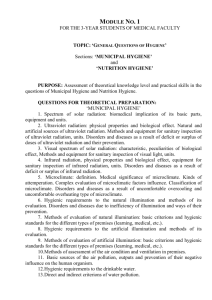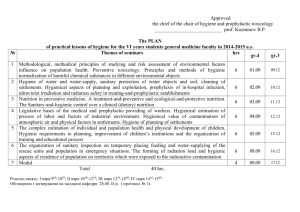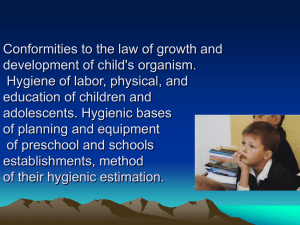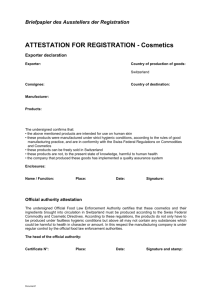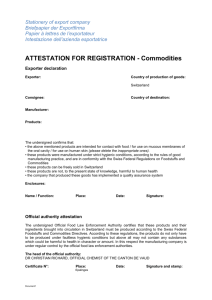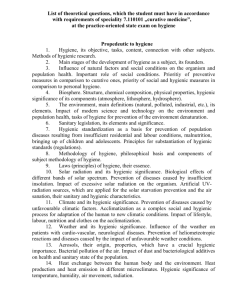Questions on hygiene
advertisement
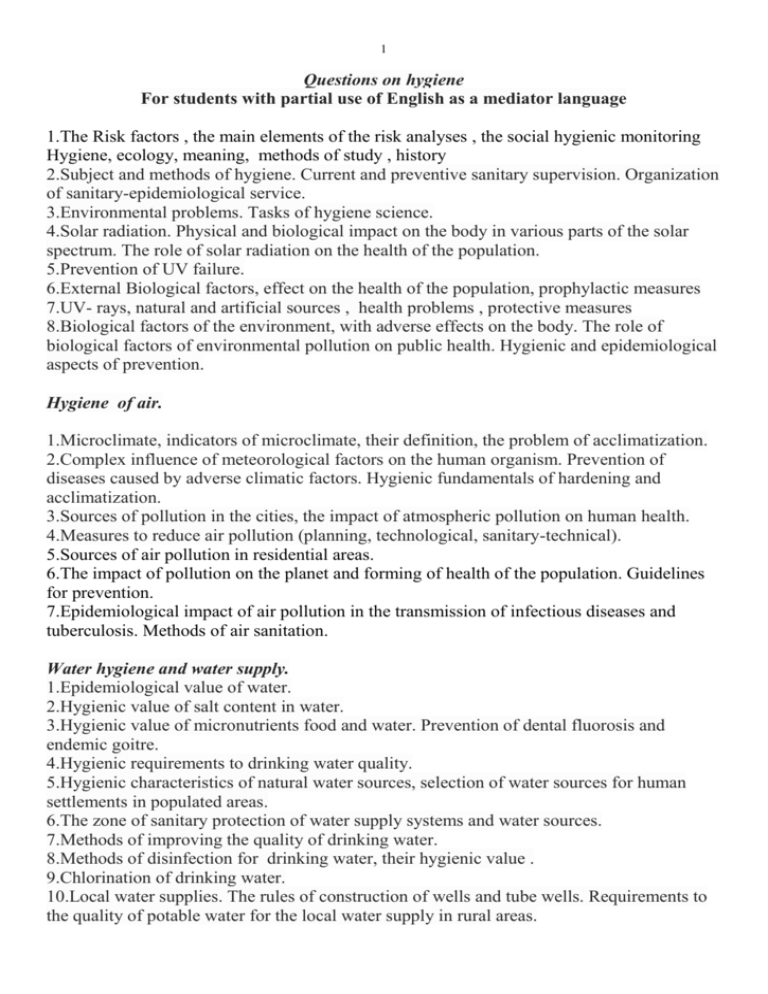
1 Questions on hygiene For students with partial use of English as a mediator language 1.The Risk factors , the main elements of the risk analyses , the social hygienic monitoring Hygiene, ecology, meaning, methods of study , history 2.Subject and methods of hygiene. Current and preventive sanitary supervision. Organization of sanitary-epidemiological service. 3.Environmental problems. Tasks of hygiene science. 4.Solar radiation. Physical and biological impact on the body in various parts of the solar spectrum. The role of solar radiation on the health of the population. 5.Prevention of UV failure. 6.External Biological factors, effect on the health of the population, prophylactic measures 7.UV- rays, natural and artificial sources , health problems , protective measures 8.Biological factors of the environment, with adverse effects on the body. The role of biological factors of environmental pollution on public health. Hygienic and epidemiological aspects of prevention. Hygiene of air. 1.Microclimate, indicators of microclimate, their definition, the problem of acclimatization. 2.Complex influence of meteorological factors on the human organism. Prevention of diseases caused by adverse climatic factors. Hygienic fundamentals of hardening and acclimatization. 3.Sources of pollution in the cities, the impact of atmospheric pollution on human health. 4.Measures to reduce air pollution (planning, technological, sanitary-technical). 5.Sources of air pollution in residential areas. 6.The impact of pollution on the planet and forming of health of the population. Guidelines for prevention. 7.Epidemiological impact of air pollution in the transmission of infectious diseases and tuberculosis. Methods of air sanitation. Water hygiene and water supply. 1.Epidemiological value of water. 2.Hygienic value of salt content in water. 3.Hygienic value of micronutrients food and water. Prevention of dental fluorosis and endemic goitre. 4.Hygienic requirements to drinking water quality. 5.Hygienic characteristics of natural water sources, selection of water sources for human settlements in populated areas. 6.The zone of sanitary protection of water supply systems and water sources. 7.Methods of improving the quality of drinking water. 8.Methods of disinfection for drinking water, their hygienic value . 9.Chlorination of drinking water. 10.Local water supplies. The rules of construction of wells and tube wells. Requirements to the quality of potable water for the local water supply in rural areas. 2 11. particular qualities of water sources and treatment of water in centralized water supply in rural areas. 12Problems of drinking water in developing countries ( Quality of drinking water ) 13.Improvement of water quality as a factor. What diseases may be associated with water. Epidemiological and hygienic assessment methods for water quality improvement. Hygiene of soil. 1.Soil, epidemiological significance. Indicators of the sanitary condition of soil. 2.Biogeochemical province and geochemical endemic diseases. 3.Hygienic characteristics of the methods of cleaning solid waste. 4. of pollution of open water sources, hygienic and epidemiological problems, the main causes of their pollution. 5.Sanitary-epidemiological value of soil. Methods of disinfection of sewage and waste. Role of soil in the transmission of infectious diseases. Activities in the epidemiological areas. Hygiene of dwellings and populated areas. 1.Basic hygiene principles of planning of inhabited areas. Choice of the territory zoning, building residential zone, the value of green plantings. 2.The change of chemical and bacteriological composition of the indoor air, natural and artificial ventilation. 3.Transmission of airborne infection. Bacterial pollution of the indoor air , sanitation methods of air in the room. 4. Natural light in the room. Factors affecting the level of the natural light. 5.The problems of the big cities in developing countries , preventive measures 6. Artificial lighting in the room, hygienic requirements. 7.The main hygienic and ecological problems in rural areas of the developing countries Hygiene of nutrition 1.The role of food in the transmission of infectious diseases and the occurrence of food poisoning. Classification of food poisoning. The General principles of prevention. The procedure for investigating cases of food poisoning. 2.The role of the different food groups to ensure the normal life of a child's organism. Consumption of food products. The role of the different food groups in the transmission of infections, poisoning, and helminthes. Guidelines for prevention. 3.Nutrition as a factor of formation of health of the population. Excessive and inadequate nutrition. Methods of assessing the adequacy of supply. Physiological nutritional standards and norms of consumption of products. 4.Hygienic justification of rational nutrition of different age and professional groups. 5.Proteins, their importance in nutrition. Proteins. Hygienic norms, depending on age, the nature of work. Products - sources of protein. 6.Fats and their importance in nutrition. Fats. Hygienic norms of fats, depending on age, climate, nature of the work. 7.Carbohydrates, their importance in nutrition. Hygienic norms. Foods rich in carbohydrates. 8. Vitamin A, its importance in human nutrition, daily need, sources of vitamin A and carotene. 9.Vitamin D, its importance in human nutrition, daily need, source. 3 10.Vitamins C, its importance in human nutrition, daily need, sources. 11.Vitamins B1 and B2, their importance in human nutrition, daily need, sources. 12.Vitamin PP and its importance in human nutrition, daily need, sources. 13. Vitamin C,A and P, and their importance in nutrition. 14.Flour and bread, their importance in human nutrition, prevention of diseases associated with consumption of low-quality flour and bread. 15.Meat and meat products, their importance in human nutrition. Prevention of diseases associated with consumption of low-quality meat products. 16.Milk and dairy products, their importance in human nutrition. Prevention of diseases related to the use of substandard or poor quality milk. 17.Fish and fish products, their importance in human nutrition. Prevention of diseases related to the use of substandard fish. 18.Food poisoning. Their classification. Food poisoning bacterial nature. 19.Bacterial food poisoning (toxicoifection), prevention. 20.Bacterial food poisoning (staphylococcal alimentary toxicoses), prevention. 21.Food toxicosis, caused by Clostridium botulinum. Prevention. 22 Mycotoxicoses. Their prevention. 23.Prevention of food poisoning because of poisonous products as mushrooms, and poisonous plants. 24.The procedure for investigating cases of food poisoning. 25.Kitchen in hospitals, planning , equipment, medical control the health of the personnel. Professional diseases , Occupational noise dust, vibration and toxicology 1.The organization of health care workers and employees in industrial enterprises. The content and forms of work of the doctor of medical-sanitary part of the industrial enterprises. 2.Environmental pollution with chemical substances. Sources of pollution-. The transformation of chemicals in the environment. The impact of chemical pollution on the health of the population. Guidelines for prevention. 3.Factors of the production process, their effect on the organism. Production hazards and occupational diseases. Guidelines for prevention of occupational diseases. 4-Harmful factors in industrial areas , preventive measures , function of the medical personal 5.Dust as adverse factor (specific and nonspecific) effects on the body. Dust as a factor of transmission of infections. Dust diseases and their prevention. 6.Dust, classification of dust diseases, preventive measures , function of the medical personal in the health centers of the industrial areas 7.Computer, risk factors , health problems , protective measures 8.Noise, health problems , protective measures, function of the medical personal in the health centers of the industrial areas 9.Vibration, health problems , protective measures, function of the medical personal in the health centers of the industrial areas 10. Toxic poisoning, health problems , protective measures, function of the medical personal in the health centers of the industrial areas Fundamentals of radiation safety. 1.The concept of radioactivity and radiation doses. The unit of activity and doses. 4 2.The natural radiation background. The reasons for its increase. 3.The main types of ionizing radiation. Physical characteristics and the basic properties that determine the degree of danger. 4.Closed sources of ionizing radiation, protection principles. 5.Open sources of ionizing radiation, protection principles. 6.Ionizing radiation in medicine. Features design Radiological and x-ray Department and the regime of their work. Core principles to protect staff and patients from radiation damages. Hygiene of children and adolescents. 1.Growth and development of children and adolescents. Main indicators. Acceleration. Methods of evaluation of physical development. 2.Prevention of skeletal deformities in children. 3.Prevention of respiratory diseases in children. 4.Prophylaxis of diseases of cardiovascular system in children and adolescents. 5.Prevention of digestive diseases in children. 6.Prevention of myopia in children and adolescents. 7.Hygienic requirements to the organization of classes at school. 8.Exhaustion, fatigue among schoolchildren. Causes, prevention. 9.Medical control over physical education of pupils. 10.Hygienic requirements for the planning schools. 11.Hygienic requirements for the planning of preschool children's institutions. 12.Organization of the educational regime in kindergartens. 13.The basic hygiene regime for children of preschool and school age. 14.Hardening, definition, principles, methods of hardening. 15.Organization of treatment-and-prophylactic and anti-epidemic work of the doctor preschool and school institutions, as well as doctors of the children's summer health institutions. Hygiene of medical institutions. 1.Planning system of hospitals. Their hygienic assessment. Hygienic requirements to placement of hospitals in terms of the city. Functional zoning of the land plot hospitals 2.Hygienic requirements to the internal planning of the hospitals. Ward section, hospital ward. 3.Hygienic requirements for the planning of surgical, maternity, outpatient departments. 4.Hygienic requirements for the planning of infectious diseases hospital 5.Interhospital infection , meaning ,causes , prophylactic measures 6. Hospital planning system, problem of the hospital in developing countries 7.Creation of optimal conditions of patients in hospitals. Requirements to environmental factors in medical facilities. Prevention of inter - hospital infections. 8.Occupational hazards in medical enterprises The most frequent occupational diseases among the of the medical workers . Guidelines for prevention.
